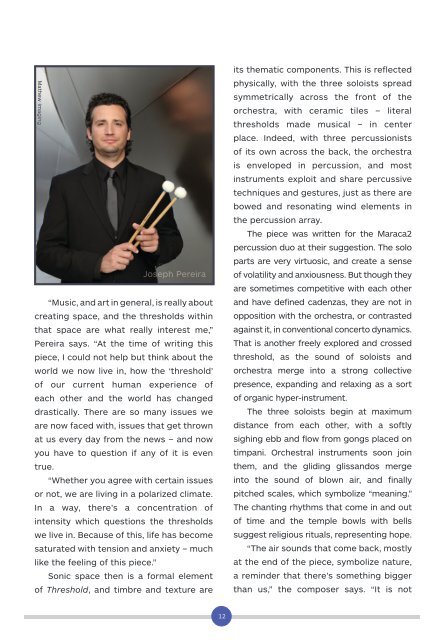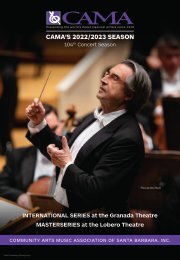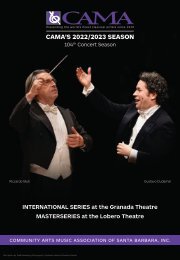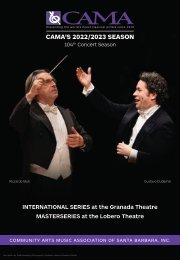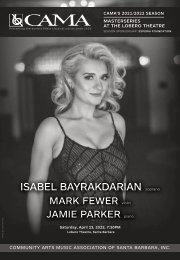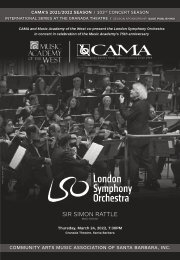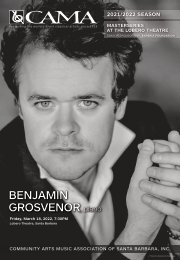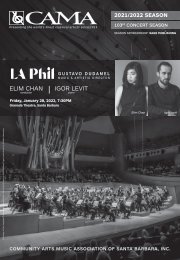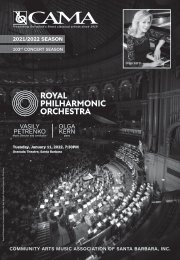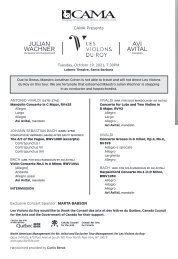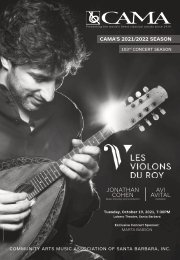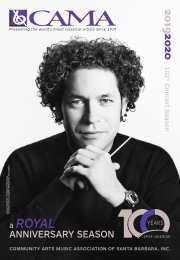January 27, 2018 – Program Notes – Los Angeles Philharmonic – CAMA's International Series at The Granada Theatre
CAMA's International Series Presents Los Angeles Philharmonic Saturday, January 27, 2018 The Granada Theatre, 8pm Gustavo Dudamel, Music Director Joseph Pereira, Timpani Maraca2, Percussion Igor Stravinsky: Fireworks, Op.4 (1908) Joseph Pereira: Threshold (world premiere weekend, LA Phil commission with generous support from Marcia and Gary Hollander) Johannes Brahms: Symphony No.1 in C minor, Op.68 “Los Angeles Has America’s Most Important Orchestra. Period.” —The New York Times At the height of their powers, Maestro Gustavo Dudamel and the Los Angeles Philharmonic return to Santa Barbara with a powerful and unique program featuring LA Phil Principal Timpanist Joseph Pereira’s new Concerto for timpani and two percussion. Featured in the concerto are Pereira and Maraca2 (percussionists Tim Palmer and Jason Huxtable), a young percussion duo who are making waves in today’s music scene. •
CAMA's International Series Presents
Los Angeles Philharmonic
Saturday, January 27, 2018
The Granada Theatre, 8pm
Gustavo Dudamel, Music Director
Joseph Pereira, Timpani
Maraca2, Percussion
Igor Stravinsky: Fireworks, Op.4 (1908)
Joseph Pereira: Threshold (world premiere weekend, LA Phil commission with generous support from Marcia and Gary Hollander)
Johannes Brahms: Symphony No.1 in C minor, Op.68
“Los Angeles Has America’s Most Important Orchestra. Period.”
—The New York Times
At the height of their powers, Maestro Gustavo Dudamel and the Los Angeles Philharmonic return to Santa Barbara with a powerful and unique program featuring LA Phil Principal Timpanist Joseph Pereira’s new Concerto for timpani and two percussion. Featured in the concerto are Pereira and Maraca2 (percussionists Tim Palmer and Jason Huxtable), a young percussion duo who are making waves in today’s music scene. •
Create successful ePaper yourself
Turn your PDF publications into a flip-book with our unique Google optimized e-Paper software.
“Music, and art in general, is really about<br />
cre<strong>at</strong>ing space, and the thresholds within<br />
th<strong>at</strong> space are wh<strong>at</strong> really interest me,”<br />
Pereira says. “At the time of writing this<br />
piece, I could not help but think about the<br />
world we now live in, how the ‘threshold’<br />
of our current human experience of<br />
each other and the world has changed<br />
drastically. <strong>The</strong>re are so many issues we<br />
are now faced with, issues th<strong>at</strong> get thrown<br />
<strong>at</strong> us every day from the news <strong>–</strong> and now<br />
you have to question if any of it is even<br />
true.<br />
“Whether you agree with certain issues<br />
or not, we are living in a polarized clim<strong>at</strong>e.<br />
In a way, there’s a concentr<strong>at</strong>ion of<br />
intensity which questions the thresholds<br />
we live in. Because of this, life has become<br />
s<strong>at</strong>ur<strong>at</strong>ed with tension and anxiety <strong>–</strong> much<br />
like the feeling of this piece.”<br />
Sonic space then is a formal element<br />
of Threshold, and timbre and texture are<br />
its them<strong>at</strong>ic components. This is reflected<br />
physically, with the three soloists spread<br />
symmetrically across the front of the<br />
orchestra, with ceramic tiles <strong>–</strong> literal<br />
thresholds made musical <strong>–</strong> in center<br />
place. Indeed, with three percussionists<br />
of its own across the back, the orchestra<br />
is enveloped in percussion, and most<br />
instruments exploit and share percussive<br />
techniques and gestures, just as there are<br />
bowed and reson<strong>at</strong>ing wind elements in<br />
the percussion array.<br />
<strong>The</strong> piece was written for the Maraca2<br />
percussion duo <strong>at</strong> their suggestion. <strong>The</strong> solo<br />
parts are very virtuosic, and cre<strong>at</strong>e a sense<br />
of vol<strong>at</strong>ility and anxiousness. But though they<br />
are sometimes competitive with each other<br />
and have defined cadenzas, they are not in<br />
opposition with the orchestra, or contrasted<br />
against it, in conventional concerto dynamics.<br />
Th<strong>at</strong> is another freely explored and crossed<br />
threshold, as the sound of soloists and<br />
orchestra merge into a strong collective<br />
presence, expanding and relaxing as a sort<br />
of organic hyper-instrument.<br />
<strong>The</strong> three soloists begin <strong>at</strong> maximum<br />
distance from each other, with a softly<br />
sighing ebb and flow from gongs placed on<br />
timpani. Orchestral instruments soon join<br />
them, and the gliding glissandos merge<br />
into the sound of blown air, and finally<br />
pitched scales, which symbolize “meaning.”<br />
<strong>The</strong> chanting rhythms th<strong>at</strong> come in and out<br />
of time and the temple bowls with bells<br />
suggest religious rituals, representing hope.<br />
“<strong>The</strong> air sounds th<strong>at</strong> come back, mostly<br />
<strong>at</strong> the end of the piece, symbolize n<strong>at</strong>ure,<br />
a reminder th<strong>at</strong> there’s something bigger<br />
than us,” the composer says. “It is not<br />
12


